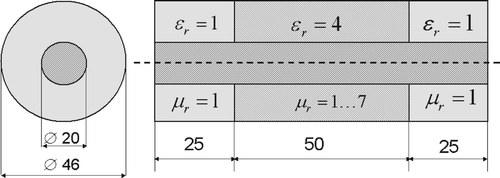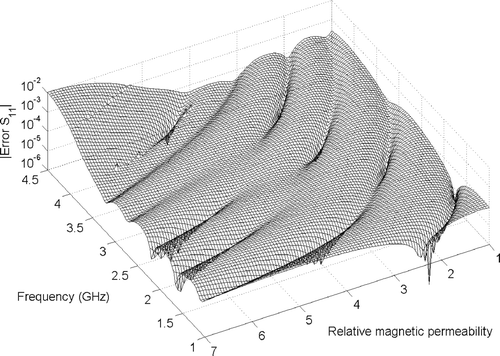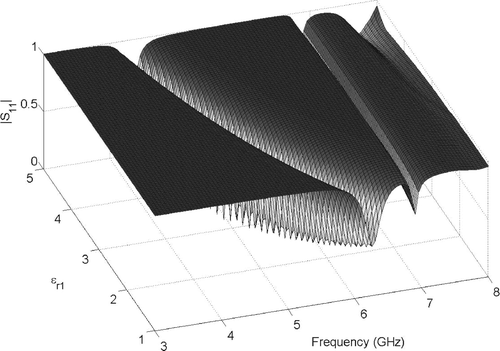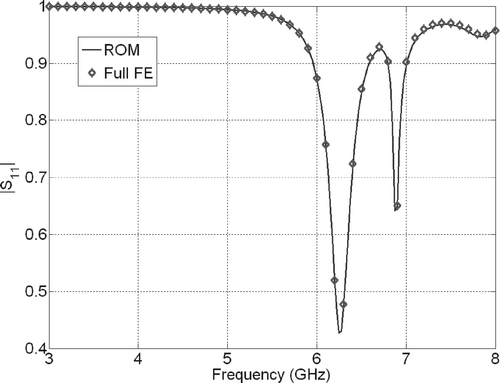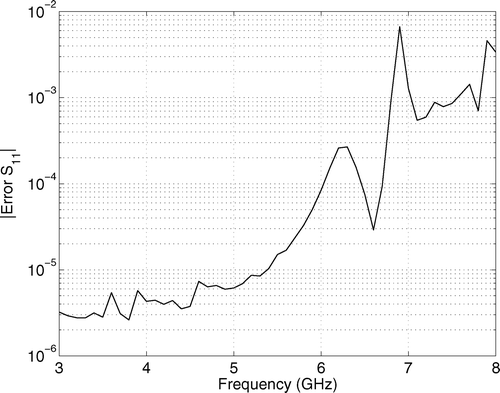Abstract
In this paper we present a numerically stable method for the model order reduction of finite element (FE) approximations to passive microwave structures parameterized by polynomials in several variables. The proposed method is a projection-based approach using Krylov subspaces and extends the works of Gunupudi etal. (P. Gunupudi, R. Khazaka and M. Nakhla, Analysis of transmission line circuits using multidimensional model reduction techniques, IEEE Trans. Adv. Packaging 25 (2002), pp. 174–180) and Slone etal. (R.D. Slone, R. Lee and J.-F. Lee, Broadband model order reduction of polynomial matrix equations using single-point well-conditioned asymptotic waveform evaluation: derivations and theory, Int. J. Numer. Meth. Eng. 58 (2003), pp. 2325–2342). First, we present the multivariate Krylov space of higher order associated with a parameter-dependent right-hand-side vector and derive a general recursion for generating its basis. Next, we propose an advanced algorithm to compute such basis in a numerically stable way. Finally, we apply the Krylov basis to construct a reduced order model of the moment-matching type. The resulting single-point method requires one matrix factorization only. Numerical examples demonstrate the efficiency and reliability of our approach.
1. Introduction
The need for broadband frequency response simulations of electrical circuits with n > 100,000 degrees of freedom led to the development of Krylov subspace based model order reduction (MOR) approaches. These methods finally found their way into the computational electromagnetics community, where they were mainly used in the context of finite element (FE) analysis.
The first widely used MOR method was the asymptotic waveform evaluation (AWE) Citation1. In this approach, the transfer function of the system is first expanded in a Taylor series about a given expansion point, and, in a second step, a Padé-approximation matching the Taylor coefficients, the so-called moments, is constructed. The resulting reduced order models (ROM) are of very low dimension, q ≪ n, and can be evaluated very efficiently. However, the direct moment computation in AWE leads to numerical instabilities that limit the bandwidth attainable. To overcome this deficiency, multi-point methods like complex frequency hopping (CFH) Citation2 and multi-point Padé-approximation Citation3 were developed. One disadvantage of multi-point methods is the need for a separate matrix factorization at every expansion point. As a cheaper alternative, numerically robust one-point methods, such as the Padé via Lanczos-Algorithmus (PVL) Citation4,Citation5, were proposed. These methods perform moment-matching only implicitly. The multi-point rational interpolation method Citation6 achieves a further increase in numerical stability by combining the latter ideas with multi-point methods to construct rational Krylov sequences Citation7.
All the aforementioned methods assume linear parameter dependence. It is always possible to linearize polynomially parameterized systems, but this comes along with increased vector lengths Citation8, which results in an additional memory consumption. Conversely, the number of matching moments can be doubled by back-converting a first-order system to higher order Citation9. An attractive alternative to linearization, avoiding the vector length increase, is the use of Krylov spaces of higher order Citation10. Modern methods using this approach are presented in Citation11 and Citation12.
In recent times, MOR has been extended to multi-parameter systems Citation13,Citation14. Additional parameters are, e.g. wire spacings Citation15 or incident angles Citation16. While most of these methods are restricted to linear parameterization, Citation13 presents an extension to polynomials in two parameters.
To our knowledge, most methods available for the multivariate case use direct moment computation and therefore suffer from the same numerical instabilities as the AWE. Only in Citation17 a first approach to increase the numerical stability is presented. The algorithm presented therein is restricted to linear parameterization. To overcome these difficulties, we present an advanced algorithm for computing well-conditioned bases for the Krylov spaces of systems parameterized by polynomials in several variables.
2 Systems parameterized by multivariate polynomials
For clarity, we restrict ourselves to a system parameterized by a quadratic polynomial in two parameters s 1 and s 2,
3 Projection-based model order reduction
Similar to the one-parameter case Citation6, MOR is achieved by projecting the system (1) on a lower dimensional subspace of dimension m ≪ n. Let v 1, v 2, …, v m ∈ C n be mutually orthonormal global shape functions, and the matrix V be defined as
4 Choice of trial space
We now show how to choose colsp{V} to achieve moment-matching between Ĥ (s 1, s 2) and H (s 1, s 2). For this purpose, we set without loss of generality u = 1 and expand the solution vector x of (1a) in a Taylor series. We get
By comparison of coefficients, we have
The proof of (13) is by induction. Because of its great similarity to that for parameter-independent right-hand-sides Citation13, details are omitted.
4.1 General case
For a linear system of equations parameterized by a polynomial of degree M in N scalar parameters, we write
5 Choice of test space
The order of matching derivatives can be increased to 2q + 1 Citation14 by choosing W such that
One disadvantage of oblique subspace projections is that important algebraic properties of the original matrices do not carry over the reduced order system. To preserve definiteness and Hermitian structure, we propose to always use Galerkin projections
6 Computation of projection basis
Present multi-parameter methods build the matrix V by explicit computation of the Krylov basis via (10) and subsequent orthogonalization Citation13-16. With increasing order q, this approach suffers from numerical cancellation. As a rationale, consider the moments x i0, i = 0, …, q. They are identical to the one-parameter case with s = s 1, and it is well known that their direct computation is ill-conditioned Citation11. One-parameter methods overcome this difficulty by using the Arnoldi or Lanczos algorithm Citation4,Citation5,Citation11,Citation20 to compute a stable basis. In the following, we present a similar method for the multivariate case.
6.1 Proposed algorithm
Our goal is to construct an orthonormal basis V for the Krylov space and replace the sequence (10) by a numerically more robust recursion.
Our starting point is the extension of the p-column basis V p = [v 1 … v p ] by the moment vector x ij of degree s = i + j. Since V p is built from the precursors of x ij , (11) and (12) imply that all x cd with degree c + d < s lie in colsp{V p }. Hence there exists a coordinate vector h cd such that
Thus, the algorithm we propose reads as follows:
Note that the matrices need not be constructed from scratch at every iteration step. Just their pth rows and columns have to be computed. Moreover, the matrices
can be updated very efficiently by orthogonalizing their rows against v
p
.
7 Numerical examples
7.1 Multivariate linearly parameterized system
shows a coaxial line with toroid-shaped inset. For this simple structure, analytical solutions are easily obtained. The system response is given by the reflection coefficient S 11 as a function of frequency f and inset permeability μ r , where the parameter domain is defined by f = 1 … 4.5 GHz and μ r = 1 … 7. We purposely choose the expansion point at (f = 3 GHz, μ r = 4), such that there is no reflection at all and construct a ROM of order q = 10. Since the structure is a two-port device, the resulting ROM is of dimension 2 · (q + 1) · (q + 2)/2 = 132. depicts the response surface for |S 11|, sampled by 201 × 201 = 40401 points. The CPU-time for computing all 40401 ROM solutions on a 2.2 GHz Pentium IV processor is less than 200 s, whereas the same number of full FE simulations would take 258 h. gives the magnitude of the error in reflection coefficient |Error S 11|,
Figure 2. Coaxial probe. Magnitude of reflection coefficient as a function of frequency and relative permeability, as computed by the proposed algorithm.
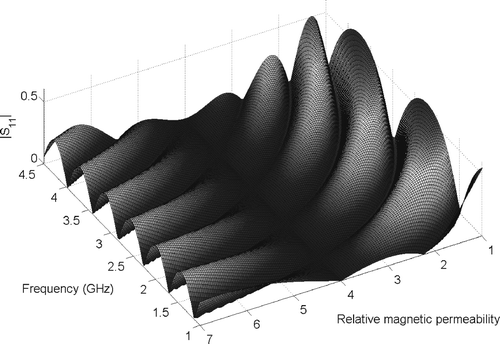
7.2 Multivariate polynomially parameterized system
We now consider the patch antenna of . The system response is the reflection coefficient S 11 as a function of frequency f = 3 … 8 GHz and the relative permittivity values of the two dielectrics ϵ r1 = 1 … 5, ϵ r2 = 1 … 3. Motivated by the authors' previous analysis of that specific design, the expansion point is chosen at (f = 6 GHz, ϵ r1 = 4, ϵ r2 = 2), A FE approach Citation22 using absorbing boundary conditions and transfinite elements Citation23 results in a linear system of equations of the form
Figure 5. Patch antenna. Schematic of the geometry, featuring two different dielectrics. Dimensions are given in Citation21.
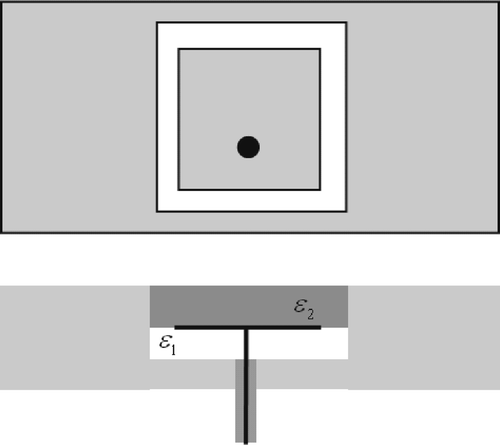
with n = 58,247 degrees of freedom. We introduce the parameters
8 Summary and outlook
We have presented a general recursion for the Krylov space of polynomially parameterized systems of linear equations with parameter-dependent right-hand sides. In addition, we have proposed an algorithm for computing a well-conditioned basis and a related single-point method for the order reduction of multi-parameter systems. Numerical examples validate the reliability of the suggested approach.
At present, the order of the ROM is set by the user directly. In the future, we intend to develop an error estimator that stops the MOR process automatically as soon as a pre-defined level of accuracy is obtained. Since the model dimension grows very rapidly when the number of parameters gets large, purging strategies that reduce the number of basis vectors without sacrificing accuracy are to be developed. Another goal of future work is to build an even more powerful tool for multivariate MOR by employing the single-point algorithm presented in this paper as a building block within a multi-point framework.
Acknowledgement
V. Hill was supported by a Grant from Ansoft Corporation. P. Ingelström was supported by a fellowship from the Alexander von Humboldt-Foundation.
References
- Pillage , L. T. and Rohrer , R. A. 1990 . Asymptotic waveform evaluation for timing analysis . IEEE Trans. Comp. Aided Design Integr. Circuits , 12 : 352 – 366 .
- Chiprout , E. and Nakhla , M. 1993 . Transient waveform estimation of high-speed MCM networks using complex frequency hopping . Multi-Chip Module Conference (MCMC) . 1993 , Santa Cruz, CA, USA. pp. 134 – 139 .
- Celik , M. 1995 . Pole-zero computation in microwave circuits using multi-point Padé approximation . IEEE Trans. Circuits Syst. I , : 6 – 13 .
- Feldmann , P. and Freund , R. W. 1995 . Efficient linear circuit analysis by Padé approximation via the Lanczos process . IEEE Trans. Comp. Aided Design Integr. Circuits , 14 : 639 – 649 .
- Gallivan , K. , Grimme , E. and Van Dooren , P. 1994 . Asymptotic waveform evaluation via a Lanczos method . Appl. Math. Lett. , 7 : 75 – 80 .
- Grimme , E. Krylov projection methods for model reduction Ph.D. diss., Coordinated-Science Laboratory, University of Illinois at Urbana-Champaign, 1997
- Ruhe , A. 1984 . Rational Krylov sequence methods for eigenvalue computation . Lin. Alg. Appl. , 58 : 391 – 405 .
- Slone , R. D. and Lee , R. 2000 . Applying Padé via Lanczos to the finite element method for electromagnetic radiation problems . Radio Science , 35 : 331 – 340 .
- Salimbahrami , B. and Lohmann , B. 2006 . Order reduction of large scale second order systems using Krylov subspace methods . Linear Algebra Appl. , 415 : 385 – 405 .
- Su , T. J. and Craig , R. R. Jr. 1989 . Model reduction and control of flexible structures using Krylov vectors . J. Guidance , 14 : 260 – 267 .
- Slone , R. D. , Lee , R. and Lee , J.-F. 2003 . Broadband model order reduction of polynomial matrix equations using single-point well-conditioned asymptotic waveform evaluation: derivations and theory . Int. J. Numer. Meth. Eng. , 58 : 2325 – 2342 .
- Bai , Z. and Su , Y. 2005 . Dimension reduction of second-order dynamical systems via a second-order Arnoldi method . SIAM J. Sci. Comput. , 26 : 1692 – 1709 .
- Gunupudi , P. , Khazaka , R. and Nakhla , M. 2002 . Analysis of transmission line circuits using multidimensional model reduction techniques . IEEE Trans. Adv. Packaging , 25 : 174 – 180 .
- Weile , D. S. 1999 . A method for generating rational interpolant reduced order models of two-parameter linear systems . Appl. Math. Lett. , 12 : 93 – 102 .
- Daniel , L. 2004 . A multiparameter moment-matching model-reduction approach for generating geometrically parameterized interconnect performance models . IEEE Trans. Comp. Aided Design Integr. Circuits , 23 : 678 – 693 .
- Weile , D. S. and Michielssen , E. 2001 . Analysis of frequency selective surfaces using two-parameter generalized rational Krylov model-order reduction . IEEE Trans. Antennas Propagat. , 49 : 1539 – 1549 .
- Codecasa , L. 2005 . A novel approach for generating boundary condition independent compact dynamic thermal networks of packages . IEEE Trans. Compon. Packaging , 28 : 593 – 604 .
- Odabasioglu , A. , Celik , M. and Pileggi , L. T. 1998 . PRIMA: passive reduced-order interconnect macromodeling algorithm . IEEE Trans. Comp. Aided Design Integr. Circuits , 17 : 645 – 654 .
- R.W. Freund, Passive reduced-order modeling via Krylov subspace methods, Numerical Analysis Manuscript No. 00-3-02, (2000). Available at http://cm.belllabs. com/cs/doc/00
- Boley , D. L. 1994 . Krylov space methods on state-space control models . Circuits Syst. Signal Process , 13 : 733 – 758 .
- González de Aza , M. 1998 . Full-wave analysis of cavity-backed and probe-fed microstrip patch arrays by a hybrid mode-matching generalized scattering matrix and finite-element method . IEEE Trans. Antennas Propagat. , 46 : 234 – 242 .
- Bossavit , A. and Mayergoyz , I. 1989 . Edge-elements for scattering problems . IEEE Trans. Magn. , 25 : 2816 – 2821 .
- Cendes , Z. J. and Lee , J.-F. 1988 . The transfinite element method for modeling MMIC devices . IEEE Trans. Microwave Theory Tech. , 36 : 1639 – 1649 .
